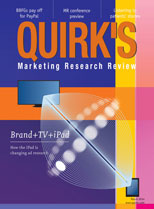Editor's note: Cory Lebson is principal at Lebsontech LLC User Experience Consulting, Silver Spring, Md. He can be reached at cory@lebsontech.com. This article appeared in the March 24, 2014, edition of Quirk's e-newsletter.
While both marketing research and user experience (UX) research certainly add commercial value, marketing research is focused on getting the right product sold with the right branding and messaging, while UX is about making sure that the Web, mobile resource or electronic device released to the public can be used appropriately.
The official definition of usability (ISO 9241-11) is "the extent to which a product can be used by specified users to achieve specified goals with effectiveness, efficiency and satisfaction in a specified context of use." While usability does seek to understand the target audience, the reason for that understanding is to make sure that they can use the product appropriately and will be satisfied.
When I teach UX professionals how to conduct usability testing, I frame the conversation around the knowledge that they already have about the field of UX. Though UX professionals may be more expert at the creative aspects of UX, they don't necessarily have a strong understanding of what exactly it means to do qualitative research. However, when I teach qualitative marketing researchers how to conduct usability testing, the starting point is different. These researchers may be very skilled at qualitative techniques but they are sometimes not as well versed in UX and the nuances of usability and user interface best practices. Therefore, I start with what it means for a product to have good usability.
Assess the quality
Qualitative researchers should know what to look for during usability testing. While it's fine and sometimes useful to note offhand comments that participants may make about a brand or that have implications for marketing the product, the core goal of usability testing is to assess the quality of the user experience.
This means that when researchers are drafting a test plan, they should review the interface first and determine what points of potential confusion may exist within the larger context of the current state of UX best practices. They can annotate the test plan with probing questions as appropriate but must determine, to whatever extent possible, which probing questions are likely to present information about the interface to the user that will provide context for future tasks. The researchers need to keep a careful eye on the participants' actual usage of the interface as a primary activity instead of focusing on what the participant said. The researcher needs to be ready to add supplemental probes about behaviors more than spoken comments.
Task of a logger
The task of a logger accustomed to other forms of qualitative marketing research may be a bit different as well during usability testing. The logger in a usability test will often have a simultaneously-recorded screen that mirrors a Web or mobile interface that a participant is using. The logger would generally not be transcribing the session. Instead, the logger notes observations about participant performance and interaction with the interface and identifies points where the participant performs a wrong or unexpected action, as well as whether the participant completed each task with or without difficulty and in some cases, how long each task took.
The logger may also note what the participant says around their performance but this is secondary to what the participant actually does. In addition, the logger may make notes on performance directly into the recording and the team can use these notes later to pick out performance highlights to inform the development team on what needs to be corrected.
Within the context
The issues and recommendations that are uncovered during usability testing need to be within the UX context. Specifically, issues should be framed to explain what in the interface is faulty or doesn't meet general UX best practices. Recommendations should be focused on bringing the interface toward these best practices. An understanding of what current best practices are is a critical base for reporting findings and suggesting recommendations.
A more technical context
While marketing research may go to key stakeholders and be used to adjust marketing or branding efforts, usability testing reports will go to stakeholders to have the design or development team make changes to the interface. A usability testing report, therefore, will often be framed within a more technical context, which at a minimum requires a basic understanding of the current technology standards and inherent capabilities of the technologies being used.
Navigate both
There are certainly many qualitative researchers who navigate both marketing research and usability testing successfully. The strong caveat in doing so, however, is that qualitative researchers need to spend the necessary time to become fully versed in what UX is all about - what it means to research and report in light of usability best practices and the technical reporting approach necessary to communicate with the design and development team.
